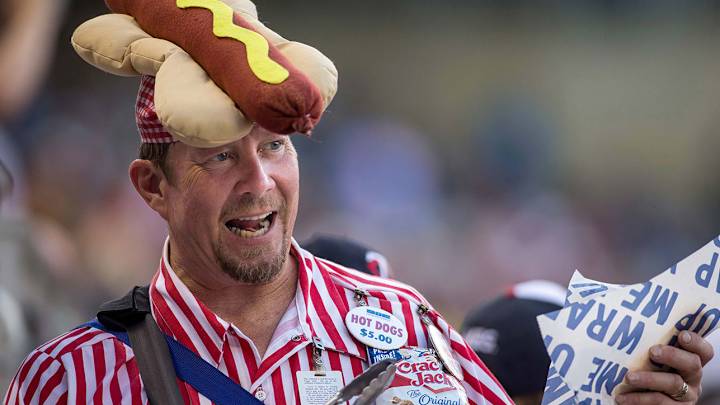Without Sports, What's Happened to the Peanut and Hot Dog Industries?

With Major League Baseball shut down, every corner of the sport has been affected—players, stadium workers, giant flags. And, of course, peanuts and hot dogs.
In an MLB season, fans typically consume somewhere around 18 million hot dogs and 4 to 7 million bags of peanuts. (There are millions more consumed in the minors and indy ball, but those totals are not tracked as diligently.) The food items are as much a part of the cultural presence of the sport as is anything that happens on the field. Unsurprisingly, in a world without baseball, both industries have seen shifts.
For peanuts, the pandemic has not had a significant effect on farming: The crops are planted in May and harvested in September or October, so peanuts were gathered months before the current crisis, and farmers are preparing now to plant as usual. But the ultimate destination for many nuts now is different than it would be under normal circumstances. Baseball is a “critical part of our business,” says Rick McGee, vice president of food service sales for Hampton Farms, one of the country’s largest roasters of in-shell peanuts. Ordinarily, 25% of their nuts sold between March and October would be for stadiums, and now, that demand has vanished. (The peanuts that are delivered to restaurants, such as steakhouses, represent another chunk of sales that’s been taken off the table.)
But this sudden decline hasn’t led to disaster. There’s more to the industry: There’s peanut butter. The demand has been “literally off the charts,” according to McGee—up year-over-year in some areas by as much as 175%, in a trend that’s shown no signs of slowing. An initial rush came as people loaded their pantries with shelf-stable items in March, but sales increased in April, too, particularly for families with children. (If PB&J is generally a popular lunch choice, it’s apparently especially so when parents are trying to care for kids in a work-from-home world with no school cafeteria to fall back on.) Elsewhere, peanut butter is also a crucial item for the distributors that serve food banks, which have seen increased demand as unemployment has soared. And there’s been a modest increase in grocery sales of in-shell peanuts, too, McGee says. In all, it’s enough to help cushion the blow of no baseball.
The hot-dog industry has seen a somewhat similar movement. They’ve lost out on the millions of hot dogs that would ordinarily be eaten at baseball stadiums. (That’s regularly led by Dodger Stadium, which averaged more than one hot dog for every two tickets sold in 2019 [2.7 million total hot dogs], far ahead of second-place Wrigley Field [1.2 million hot dogs], with about one for every three.) But people are buying far more hot dogs to eat at home now—grocery sales that have more than doubled year-over-year in recent weeks, which is sufficient to account for the loss seen with stadiums and restaurants. It’s “fairly close” between the hot dogs added in retail and those lost in food service, says Eric Mittenthal, president of the National Hot Dog and Sausage Council.
As for peanuts and hot dogs that were already at stadiums before the sport shut down? A spokesperson for Delaware North, which handles concessions for 11 MLB stadiums, said that 41,000 pounds of food donated in March by the company included items that had been sent to teams in advance of Opening Day. At least one of its ballparks—the Braves’ Truist Park—has started to use its stadium kitchens and pre-purchased food to make meals for local healthcare workers. (Aramark, which operates concessions for 11 other teams in MLB, did not respond to a request for comment about its stadium food.)
The two foods have a relationship with baseball almost as old as the professional game itself. (Benjamin Harrison became the first U.S. president to eat peanuts at a baseball stadium back in 1892; hot dogs started gaining popularity around the same time, and they may even owe their name to baseball, as a term for sausages used by vendors at the Polo Grounds in 1901.) Still, when baseball returns, they may not immediately be part of the picture—if games are played without fans, or with some sort of socially distanced concessions system, peanuts and hot dogs may have to wait. But, eventually, they’ll be back.
“They have a long history together,” Mittenthal says of hot dogs and baseball. “It’s just a combination that puts a smile on your face.”

Emma Baccellieri is a staff writer who focuses on baseball and women's sports for Sports Illustrated. She previously wrote for Baseball Prospectus and Deadspin, and has appeared on BBC News, PBS NewsHour and MLB Network. Baccellieri has been honored with multiple awards from the Society of American Baseball Research, including the SABR Analytics Conference Research Award in historical analysis (2022), McFarland-SABR Baseball Research Award (2020) and SABR Analytics Conference Research Award in contemporary commentary (2018). A graduate from Duke University, she’s also a member of the Baseball Writers Association of America.
Follow emmabaccellieri